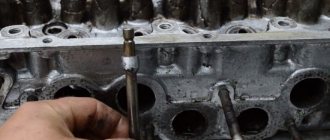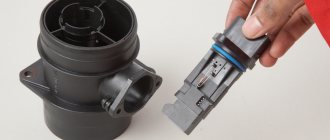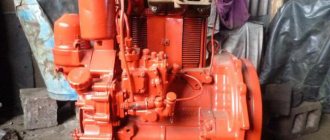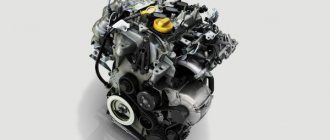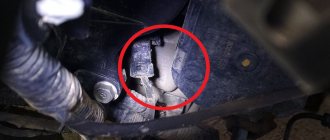The main disadvantage of the VW 1.6 MPI engine
All basic engine parts, the block and its head, are cast from aluminum alloy.
Thin-walled cast iron liners are poured into the cylinder block.
Thin-walled cast iron liners are poured into the cylinder block.
The presence of liners increases the cost of engine repairs. For example, when overhauling an engine with a cast iron block, it is enough to bore the cylinders to the repair size. And in the case of CFNA, there will be re-sleeving - removing the old sleeve, pressing in a new one and machining it. The work is more complex and requires more highly qualified performers.
Are there any advantages?
Eat. And a lot. Let's list the main ones:
- The crankshaft and its main and connecting rod bearings have a long service life. This may be due to the well-balanced shaft design.
The crankshaft is equipped with eight counterweights.
The crankshaft is equipped with eight counterweights.
- The timing drive is carried out by a reliable plate (toothed) multi-row chain. In the absence of phase shifters, there is nothing special to break. The chain resource is about 200,000 km.
Camshaft chain drive with damper, tensioner shoe and hydraulic tensioner.
Camshaft chain drive with damper, tensioner shoe and hydraulic tensioner.
- The valves are driven through rocker arms with rollers designed to reduce friction.
The cylinder head with the cover removed shows the unusual design of the engine when the camshafts are located in the cylinder head cover.
The cylinder head with the cover removed shows the unusual design of the engine when the camshafts are located in the cylinder head cover.
- Adjustment of valve clearances is not required due to the use of hydraulic rocker arms. And here the German engine puts Korean competitors on the blades, who need complex and costly adjustment of the clearances in the valve drive with replacement or grinding of the pushers.
The camshafts are located in the cylinder head cover. After its removal, very convenient access for repairs opens up - replacing hydraulic mounts or oil seals.
The camshafts are located in the cylinder head cover. After its removal, very convenient access for repairs opens up - replacing hydraulic mounts or oil seals.
CFNA tuning options
This engine has potential. Initially, there is a certain reserve of power that can be intelligently deployed. As mentioned above, the pistons and exhaust manifold of this unit are outdated. It is advisable to replace or remake them:
- VC needs to use a 4-2-1 or 4-1 bescatless;
- Install a modern cold air intake system;
- Reflash the ECU.
This will increase the power of the unit to 130 horses, without significantly reducing the resource.
The Spider 4-1 rollless exhaust manifold will increase engine power several times
Maintenance
The engine is easy to maintain. To replace the oil you need a little less than a standard four-liter canister. And it seems that no one has ever torn off the thread of the oil drain hole in a steel pan.
The oil filter is easily accessible.
The oil filter is easily accessible.
The key for the oil drain plug needs an exotic size - “18”.
The key for the oil drain plug needs an exotic size - “18”.
The rather complex design of the replaceable air filter element makes this consumable relatively expensive.
The filter element is sold complete with a huge frame.
The filter element is sold complete with a huge frame.
CFNA Fault Overview
The manufacturer insists - regularly monitor the amount of lubricant, and the engine will not cause serious problems during operation! In addition, when driving in the summer with a half-empty tank, the fuel pump is under heavy load. It may fail unexpectedly. Signs of a dying fuel pump: A strong, buzzing sound. Replacing the pump filter element can only temporarily correct this problem. In the future, only replacement will help.
The main malfunction of the presented power unit is associated with knocking or diesel noise - a familiar problem to almost all owners of the Polo Sedan. The engine literally rumbles, especially when cold. The reason lies in the special shape of the CFNA pistons and the outdated design of the exhaust manifold. There are two ways to fix this problem:
- complete replacement of pistons and VK with simultaneous reprogramming of the ECU;
- installing ET pistons instead of standard ones.
The CFNA engine pistons have a special shape. In addition, they are coated with a special protective layer
The first option will not only eliminate the knocking problem, but will also make it possible to modernize the engine. The second method is more suitable for new motors that are still under warranty. You can order such work from a dealer if the noise level is really annoying.
CFNA knocks also occur when driving on uneven road surfaces. As a rule, this is due to a weakening of the engine mount - most often the left mount. It cannot withstand loads and quickly collapses.
Another malfunction, again related to the exhaust manifold. Over time, cracks appear on it. Signs of a broken VC will be the changed sounds of the internal combustion engine during operation. As in the first case, the problem can be completely solved by replacing the standard collector with a more modern “spider” type. If you don’t want to change the intake, you can try welding the block using argon welding.
In addition to oil, it is also recommended to fill in high-quality fuel - gasoline for CFNA must have an octane rating of at least AI-95! This will be a guarantee against instability of speed, jerks and jolts. In addition, the piston group of this engine is coated with graphite. This protective layer wears off quickly when using low-grade gasoline. Scores appear on the inner walls of the cylinders. You should also not allow the engine to overheat frequently, realizing that a lack of oil will immediately lead to the destruction of the connecting rod bearings.
conclusions
The 1.6 MPI (CFNA) engine leaves an ambivalent feeling. On the one hand, it has very simple, reliable and convenient solutions in many design elements. On the other hand, there is an unpleasant knocking sound of a cold engine that upsets the owner. Nevertheless, many engines last up to 400,000 km, and then a major overhaul is possible - relatively expensive, but according to a standard scheme applicable to many modern engines.
Engine 1.6 MPI (front view in the direction of movement of the car): 1 - oil filter; 2 — oil filler cap; 3 — oil level indicator; 4 — camshaft position sensor; 5 — ignition coils; 6 — throttle assembly; 7 — camshaft housing; 8 — cylinder head; 9 — coolant distributor; 10 — coolant temperature sensor; 11 — low oil pressure indicator sensor; 12 — cover of the additional thermostat; 13 — control oxygen concentration sensor; 14 — cylinder block; 15 - flywheel; 16 — catalytic collector; 17 — oil pan; 18 — air conditioning compressor; 19 — auxiliary drive belt; 20 - generator
Engine 1.6 MPI (front view in the direction of movement of the car): 1 - oil filter; 2 — oil filler cap; 3 — oil level indicator; 4 — camshaft position sensor; 5 — ignition coils; 6 — throttle assembly; 7 — camshaft housing; 8 — cylinder head; 9 — coolant distributor; 10 — coolant temperature sensor; 11 — low oil pressure indicator sensor; 12 — cover of the additional thermostat; 13 — control oxygen concentration sensor; 14 — cylinder block; 15 - flywheel; 16 — catalytic collector; 17 — oil pan; 18 — air conditioning compressor; 19 — auxiliary drive belt; 20 - generator
Rear view of the engine in the direction of travel of the car: 1 - main thermostat cover; 2 — coolant temperature sensor; 3 — coolant distributor; 4 - throttle assembly; 5 - eye; 6 — ignition coils; 7 — camshaft position sensor; 8 — oil level indicator; 9 — fuel rail; 10 — camshaft housing; 11 — oil filler cap; 12 — valve of the crankcase ventilation system; 13 — cylinder head; 14 — auxiliary drive belt; 15 — coolant pump; 16 — auxiliary drive pulley; 17 — timing cover; 18 — pipe for supplying coolant to the pump; 19 — cylinder block; 20 — oil pan; 21 — drain plug; 22 — inlet pipeline; 23 — adsorber purge valve; 24 - flywheel
Rear view of the engine in the direction of travel of the car: 1 - main thermostat cover; 2 — coolant temperature sensor; 3 — coolant distributor; 4 - throttle assembly; 5 - eye; 6 — ignition coils; 7 — camshaft position sensor; 8 — oil level indicator; 9 — fuel rail; 10 — camshaft housing; 11 — oil filler cap; 12 — valve of the crankcase ventilation system; 13 — cylinder head; 14 — auxiliary drive belt; 15 — coolant pump; 16 — auxiliary drive pulley; 17 — timing cover; 18 — pipe for supplying coolant to the pump; 19 — cylinder block; 20 — oil pan; 21 — drain plug; 22 — inlet pipeline; 23 — adsorber purge valve; 24 - flywheel
| Specifications | |
| Type | gasoline, four-stroke, four-cylinder, in-line |
| Location | front, transverse |
| Working volume, cm3 | 1598 |
| Number of valves | 16 |
| Timing drive | multi-row leaf chain |
| Cylinder diameter × piston stroke, mm | 76,5×86,9 |
| Compression ratio | 10,5 |
| Rated power, kW (hp) at crankshaft rotation speed, min—1 | 77,0 (105) 5250 |
| Maximum torque, N∙m at crankshaft rotation speed, min—1 | 153 3800 |
| Crankshaft rotation speed at idle speed, min—1 | 600–750 |
All problems of the Volkswagen 1.6 engine - “Behind the Wheel” examination
Description of the CFNA engine
The CFNA engine is installed on several car models, including the Volkswagen Polo Sedan
The CFNA engine is a four-cylinder power plant equipped with 16 valves. The power supply system is implemented using distributed injection. One of the features of the engine is a DOHC type gas distribution mechanism - 2 camshafts are installed in the cylinder head.
When developing this internal combustion engine, Volkswagen did not plan to introduce unique advanced elements, so the engine turned out to be ordinary, although some features stand out:
- All elements of the GRS mechanism are securely hidden under plastic covers, and bright paint is applied to important components;
- The BC is made of aluminum alloy, which significantly reduces the weight of the block and increases heat transfer. The main channels of the oil system found their place here;
- The sleeves are thin-walled, made of durable material;
- The cylinder head is of a one-piece design, made like the cylinder head - from aluminum.
The CFNA lubrication system is of a universal type, only important components are processed under pressure, the remaining parts are treated by spraying. Lubricant is pumped through a pump installed in the crankcase. It rotates via the crankshaft.
The injection system is of a distributed type. Due to the harmonious functioning of the injectors and throttle assembly, the supply of fuel assemblies is balanced. In a particular case, the throttle is responsible for the flow of air into the engine cylinders under a strict dosage. When the damper is open, air masses are drawn in, a flammable mixture is formed, which then goes to the BC. The fuel supply system is directly controlled by electronics, receiving signals from sensors and a controller.


